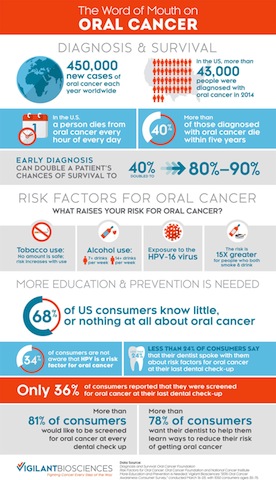The other day I visited my dentist for a regular check-up. At one point, the dentist asked me to open my mouth wide and stick out my tongue. When I did, he grasped my tongue with a tissue, moved it from side to side, lifted it and leaned in close with a light to check inside my mouth. This isn’t the only time my dentist did this, but it’s the first time I bothered to find out why. Later, I learned that he was examining my mouth for lesions or abnormal patches of cells that might have the potential to become cancerous.
Although health care organizations disagree about the need for oral cancer screening, there are many people who might benefit from this test to detect mouth cancer or precancerous lesions that might lead to the disease. According to health experts, people who use tobacco of any kind, drink lots of alcohol, have exposed themselves to massive amounts of sun and had a previous diagnosis of oral cancer may be the best candidates for mouth cancer screening. What’s more, people who have been exposed to the HPV-16 virus face a higher risk of developing oral cancer.
In addition to the routine examination dentists do to check for mouth cancer, there’s also a rinse and spit test that uses special blue dye that tests for abnormal cells. Another test involves the dentist shining a light into the mouth to check for any abnormal tissues. Yet another screening test is an oral cancer risk assessment system created by Vigilant Biosciences to evaluate someone’s risk of cancer. The test features technology that detects specific protein markers that can show if an individual has a high risk of oral cancer. Vigilant Biosciences expects to submit a request to the Food and Drug Administration for premarket notification of this assessment system in the United States later this year.
“Regular screening and early detection are absolutely essential in the fight against oral cancer,” says the chief dental officer for Vigilant Biosciences, John Comisi, DDS. “Given that early diagnosis can more than double a person’s chance of survival, it is critical that both patients and their dentists take action to avoid late-stage detection. Any steps we can take to raise awareness about this issue and enhance screening practices will help us increase the survival rate for oral cancer.”
According to the American Cancer Society’s (ACS) most recent estimates, about 40,000 people will get cancer in the mouth and throat, and nearly 8,000 people will die of these cancers. Specifically, these cancers will affect the lips, the inside lining of the lips and cheeks, the teeth, the gums, the front two-thirds of the tongue, the floor of the mouth below the tongue and the bony roof of the mouth. These areas are easily seen by a dentist during an examination. The part of the throat just behind the mouth includes the back third of the tongue, the back part of the roof of the mouth, the tonsils and the side and back wall of the throat.
The ACS reports that these cancers are more than twice as common in men as in women, and they are about equally common in blacks and in whites. In addition, the average age of most people diagnosed with these cancers is 62, but they may also strike younger people.
When Vigilant Biosciences polled almost 1,000 U.S. consumers online to find how much they knew about risk factors for oral cancer and what kind of screening tools they preferred, the company created an infographic that summarized key findings in the survey.
That infographic is shown below. I think you’ll find it interesting reading in connection with April being Oral Cancer Awareness Month.


Thinkstock (Model(s) used for illustrative purposes only)







Comments
Comments